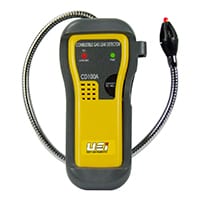The Best Gas Leak Detectors
If you have an older home or gas appliances, it’s only natural to be worried about leaks. (See what I did there?) But unless you’re part bloodhound, most natural gas leaks are notoriously difficult for the average homeowner to detect and pinpoint.
Fortunately, there are a variety of gas leak detectors that are both affordable and simple enough for anyone to use. Our favorite is the UEi Combustible Gas Leak Detector.
Best gas leak detector reviews
1. UEi Combustible Gas Leak Detector: Best overall
*Amazon.com price as of 7/30/21 at 9:00 a.m. (MT). Read full disclaimer.
The UEi Test Instruments Combustible Gas Leak Detector can be found near the top of almost any list of the best gas leak detectors. It gets gold stars for good reasons: this meter is accurate and easy to use, with an extra-long 18-inch gooseneck to get into hard-to-reach spots. The LED light on the end of the sensor can help you confirm the exact location of a leak, but the probe head is a little bit larger than similar detectors, so it might be tough to get it into extra-tight spaces. We like the headphone jack so you can do your sneaky leak-detecting activities without alarming (or annoying) other members of your household.
This detector doesn’t have an auto-calibration feature, but calibration is easy, and doing it yourself ensures you’ll get accurate readings every time. The only drawback we’ve found with the UEi is that the dial wheel on the front can become loose over time, but if it happens within a year of purchase, it’s covered under UEi’s one-year limited warranty.
The UEi Combustible Gas Leak Detector senses the following gases: acetone, alcohol, ammonia, benzene, butane, ethylene oxide, gasoline, halon, hydrogen sulfide, industrial solvents, jet fuel, lacquer thinners, methane, naphtha, natural gas, propane, refrigerants, toluene.
2. Amprobe Gas Leak Detector: Best for measuring gas levels
*Amazon.com price as of 7/30/21 at 9:00 a.m. (MT). Read full disclaimer.
A lot of consumer gas leak detectors increase the speed of audible warnings when gas is present, but the Amprobe Gas Leak Detector will also give you a light show. It has five distinct LED lights with PPM (parts per million) ratings to let you know approximately how much gas is in the air. This feature makes it much easier to hone in on leaks, because the amount of gas will increase the closer you get.
Along with the cool light show, the Amprobe will also do some of the work for you: it automatically calibrates at startup (which takes about a minute), and it will turn itself off after 10 minutes to conserve battery life. These are useful features unless you’re planning to use your meter for longer than 10 minutes—then it can get frustrating to turn it back on and wait for another minute while it calibrates. The Amprobe also has an extra-long 18-inch gooseneck like the UEi, but it tests for the presence of only methane and propane gases.
3. ALOPLEX Portable Gas Detector: Budget pick
*Amazon.com price as of 7/30/21 at 9:00 a.m. (MT). Read full disclaimer.
At about a quarter of the price of the other top detectors on our list, you might be wondering if we’ve been sniffing a little too much gas—but despite its low price, this gas detector is a top contender.
The ALOPEX Portable Gas Detector is highly sensitive and can sniff out leaks with the best detectors on the market. The adjustable sensitivity dial makes it easier to pinpoint a leak, because you can start off at a high sensitivity level and then gradually work your way down until you identify the leak’s location. Keep in mind that this detector does have a bit of a lag time, so make sure when you’re searching to slow down and smell the roses—gases, that is—so you know you’re getting an accurate location.
The ALOPEX Portable Gas Detector senses acetylene, benzene, ethane, halogenated hydrocarbons, pentane, propane, and more.
4. Kidde Nighthawk: Best home gas alarm
*Amazon.com price as of 7/30/21 at 9:00 a.m. (MT). Read full disclaimer.
If you want to make sure the air in your home is safe but you’d rather leave the gas sleuthing up to the experts, the Kidde Nighthawk monitors 24/7 for gas and sneaky carbon monoxide. The Nighthawk gives readouts of gas levels every 15 seconds, and it will sound an 85 dB alarm if gas levels are too high.
Because it has both an AC adapter and a 9-volt battery, you can place it on a tabletop or mount it on your wall. We recommend keeping it plugged in, since the battery doesn’t last long and is more of a backup in case the power goes out. We also don’t recommend it for small spaces like campers if you value your eardrums and your sanity. The alarm is loud and it’s highly sensitive to fumes from everyday things like nail polish, paint, and even cooking with wine.
The Kidde Nighthawk senses carbon monoxide, natural gas, propane.
5. Ridgid Combustible Gas Detector: Most durable
*Amazon.com price as of 7/30/21 at 9:00 a.m. (MT). Read full disclaimer.
The Ridgid Gas Detector has a durable design and lifetime warranty. You can choose between visual, audible, or vibrating alerts, and the sensitivity is adjustable. The Ridgid automatically calibrates when you turn it on, but it takes a full 90 seconds before it’s ready to go. It also has a slight lag in its gas detection that can make it difficult to pinpoint a leak, and it takes a while to get back to neutral after detecting a leak. On the plus side, it’s a little quieter than most gas leak detectors—it will beep and light up, but you won’t be startled out of your socks by this one.
The Ridgid Combustible Gas Detector senses ammonia, acetaldehyde, benzene, ethane, ethanol, ethylene, hydrogen, hydrogen sulfide, hexane, isobutane, methane, p-Xylene, propane, and toluene.
6. Techamor Yeezou Portable Gas Detector: Easiest to use
*Amazon.com price as of 7/30/21 at 9:00 a.m. (MT). Read full disclaimer.
The bright yellow Techamor Yeezou is the easiest to use on our list. This device uses six LEDs and an 85-decibel alert to let you know if there are high concentrations of potentially harmful gases in your environment. It has a 12-inch probe, 10-hour battery life, and a low battery indicator. It takes only about 10 seconds to warm up, and it can register a leak in under two seconds. It comes with a protective carrying case, and you can adjust the sensitivity to better pinpoint the location of dangerous leaks.
The Techamor Yeezou detects alcohol, ethanol, gasoline, methane, natural gas, and propane.
FAQs
For both carbon monoxide and combustible gas leaks, gather your family members and pets and get outside in a safe location with fresh air. Use a phone outside of the home to call your local fire department for assistance. They will come to your home in protective gear and check out the leak. They can help you find professionals to remedy the problem, and they can let you know when it’s safe to enter your home again.
The soap bubble technique is when you use a solution of soap and water (kids’ bubble solution works great) and spray it onto potential gas leak locations, like joints and valves. Any leaking air will cause the solution to bubble up, making it easy to see where gas is escaping.
If you try to use this method on its own, you might find yourself spraying soap all over the place without much luck, so it’s a smart idea to use this technique along with a gas leak detector. Once the detector has helped you narrow down your search area, a quick bubble test will let you pinpoint exactly where the problem is coming from.
The only time soap bubbles don’t work well is if the leak is in a hard-to-reach location. In that case, a gas leak detector with a long, flexible probe is your best bet.
Gas detectors might seem like intimidating gadgets, but they’re really just a grownup game of hot and cold. Just turn it on outside or in another neutral location away from anything that might set it off. It should start ticking, beeping, or flashing rhythmically. As you get closer to a leak, the ticking, beeping, or flashing lights will get faster. As you get farther away, they slow down again. They might be alerting you to lethal hazards, but they’re also kind of fun.
Natural gas is a type of fuel burned to heat furnaces, stoves, and water heaters. It’s highly combustible and can be dangerous if it builds up. But it has a special additive in it to give it a distinct odor like rotten eggs, so it’s easier to detect a leak.
Carbon monoxide, on the other hand, is typically odorless, and is a byproduct of burning fuel, like gasoline in cars, or natural gas in household furnaces. Without good ventilation it can build up and be poisonous to humans and animals.
No. Most handheld gas leak detectors are primarily designed to detect combustible gases, like natural gas. Be sure to check the specifications on your gas leak detector to make sure you’ll be alerted to the gas leaks you’re looking for.
Related articles on SafeWise
Disclaimer
Product prices and availability are accurate as of the date/time indicated and are subject to change. Any price and availability information displayed on Amazon at the time of purchase will apply to the purchase of this product. Safewise.com utilizes paid Amazon links.
Certain content that appears on this site comes from Amazon. This content is provided “as is” and is subject to change or removal at any time.
Recent Articles




The post The Best Gas Leak Detectors appeared first on SafeWise.
Article source here: The Best Gas Leak Detectors

